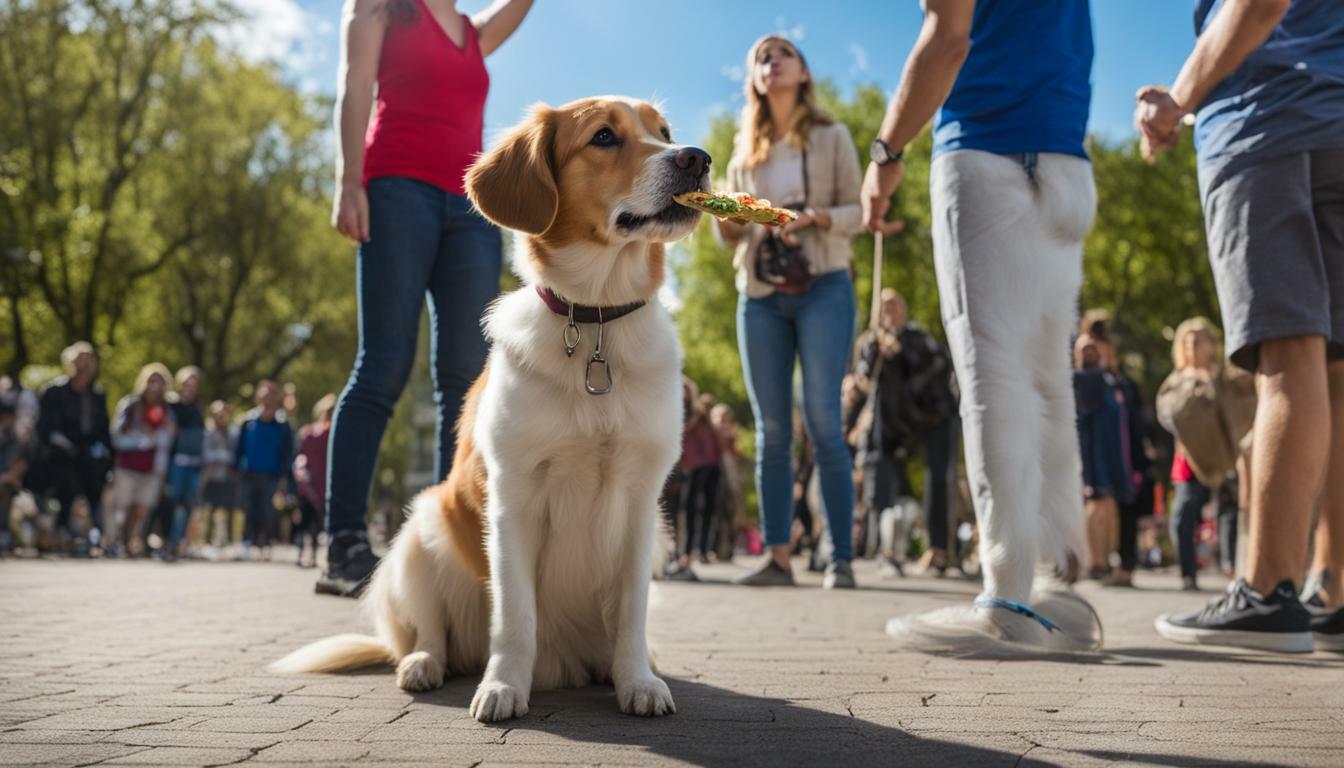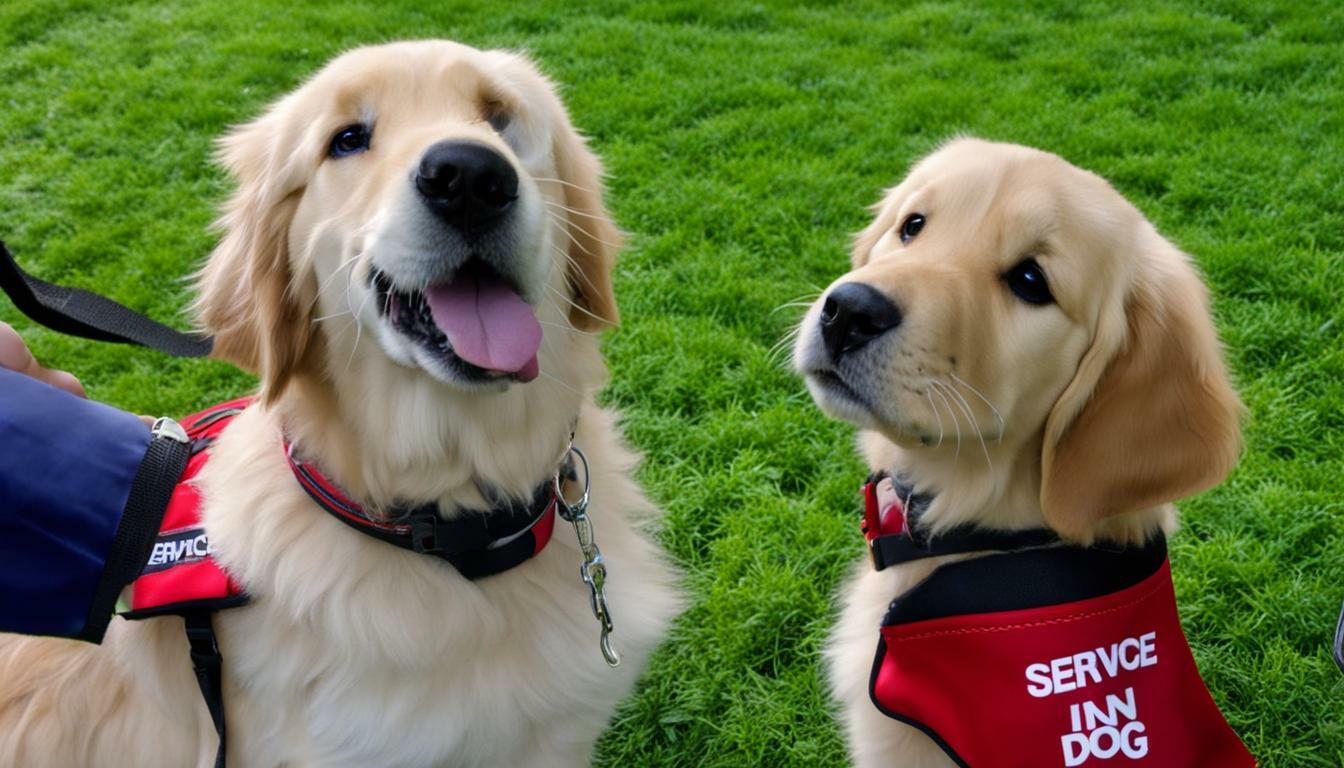If you’re wondering whether it’s possible to train your dog not to bark at strangers, the answer is yes! Dogs have various reasons for barking at strangers, including territorialism, excitement, lack of socialization, or fear. But with the right techniques and consistent training, you can help your furry friend overcome this behavior.
Key Takeaways:
- Understanding why your dog barks at strangers is essential for effective training.
- Ignoring the bad behavior and rewarding your dog when they stop barking can be an effective technique.
- Walking away from approaching strangers can show your dog that barking doesn’t lead to interaction.
- Using distraction techniques to divert your dog’s attention and rewarding them for not barking can help change their behavior.
- Training your dog to sit calmly when a stranger approaches can be an effective method.
Understanding Why Dogs Bark at Strangers
Before diving into training methods, it’s essential to understand why dogs bark at strangers in the first place. Barking is a natural behavior for dogs, and it serves as a way for them to communicate and protect their territory. When dogs encounter strangers, they may bark out of territorialism, as they see unfamiliar individuals as potential threats to their home or family.
Excitement can also trigger barking when dogs encounter new people. Some dogs become overly enthusiastic and bark as a way to release their energy. Additionally, a lack of socialization can contribute to dogs barking at strangers. Dogs who haven’t been exposed to various situations and unfamiliar people may view strangers as potential threats, leading them to bark out of fear or anxiety.
To effectively address a dog’s barking behavior, it’s crucial to identify the underlying cause. Understanding why dogs bark at strangers can help in tailoring the training methods to address specific issues. By addressing the root cause, pet owners can work towards changing their dog’s behavior and teaching them appropriate responses.
| Top Reasons Why Dogs Bark at Strangers | |||
|---|---|---|---|
| Territorialism | Excitement | Lack of socialization | Fear or anxiety |
Territorialism
When dogs perceive strangers as encroaching on their territory, they may respond with barking. This behavior serves as a way for dogs to protect their living space and their family. Recognizing territorialism as a possible cause for barking can help in implementing appropriate training methods.
Excitement
Some dogs become easily excited when they encounter new people, leading to excessive barking. This behavior is often accompanied by jumping or erratic behavior. By understanding that excitement can trigger barking, pet owners can focus on providing the necessary training to help their dogs remain calm in such situations.
Lack of Socialization
Dogs that haven’t been properly socialized may view strangers as threats due to their lack of exposure to different people and situations. This lack of socialization can lead to fear and anxiety, resulting in barking. Gradually introducing dogs to new experiences and positively reinforcing successful encounters can help in reducing their fear-based barking.
By recognizing and addressing the underlying reasons behind a dog’s barking, pet owners can implement effective training techniques and create a more harmonious environment for both their dogs and strangers. Remember, patience and consistency are key when training dogs to greet strangers calmly and politely.
Ignoring the Bad Behavior
One effective approach to train a dog not to bark at strangers is by ignoring the behavior and rewarding them when they remain silent. This technique, based on positive reinforcement, requires consistency and patience.
When your dog starts barking at a stranger, resist the urge to yell or scold them. Instead, simply turn your back and ignore the behavior. By withholding attention, you communicate to your dog that barking will not lead to any reward or interaction.
Once your dog stops barking, immediately reward them with praise, treats, or a favorite toy. This positive reinforcement reinforces the desired behavior of staying calm and silent when faced with strangers. Remember to be consistent in your approach, reinforcing the reward each time your dog remains quiet.
| Technique | Description |
|---|---|
| Ignoring the Behavior | When your dog barks at strangers, turn your back and ignore them. |
| Rewarding Silence | Immediately praise and reward your dog when they stop barking. |
| Consistency and Patience | Be consistent in your approach and patient throughout the training process. |
It’s important to note that this technique may not work overnight. Some dogs may take longer to understand the desired behavior and control their barking. Additionally, it is crucial to address any underlying reasons for the barking, such as fear or anxiety, through proper socialization and training techniques.
By consistently ignoring the bad behavior and rewarding your dog when they remain silent, you can gradually train them to greet strangers calmly and politely. Remember to provide positive reinforcement and be patient in your training efforts.
Walking Away to Show No Interaction
Another approach to discourage barking at strangers is to walk away, showing your dog that barking does not result in any form of interaction. This technique helps to teach your dog that their barking behavior does not lead to attention or engagement from strangers.
When your dog starts barking at a stranger, calmly turn and walk away, leading your dog in the opposite direction. This action sends a clear message that barking is not an effective way to interact with strangers. By removing your dog from the situation, you remove the reinforcement for their barking behavior.
Consistency is Key
Consistency is crucial when using this technique. It’s essential to remain calm and composed throughout the process. Reinforce the message that barking does not result in any interaction by consistently walking away from strangers when your dog barks. Over time, your dog will learn that barking leads to the opposite of what they desire, encouraging them to find alternative behaviors.
Additionally, it’s important to reward your dog when they exhibit calm behavior instead of barking. This positive reinforcement helps to reinforce the desired behavior and encourages your dog to remain calm in the presence of strangers.
Summary
Training a dog not to bark at strangers can be challenging, but with the right techniques and consistent practice, it is possible to change their behavior. By walking away from strangers when your dog barks, you can show them that barking does not result in any form of interaction. Remember to stay patient, be consistent, and reward calm behavior. With time and effort, you can train your dog to greet strangers calmly and politely.
Distraction Technique
A useful method to prevent barking at strangers is to divert your dog’s attention from barking through the distraction technique. This technique involves making noise to shift their focus away from the stimulus that triggers their barking. When your dog starts barking, use a loud noise, such as clapping your hands or using a whistle, to capture their attention. This sudden noise can interrupt their barking and provide an opportunity for redirection.
Once your dog stops barking, reward them with praise, treats, or their favorite toy. This positive reinforcement helps them associate not barking with receiving rewards. It is essential to be consistent in using this technique and rewarding your dog when they respond appropriately.
Incorporating training sessions to practice the distraction technique can be beneficial. Set up scenarios where people or objects trigger your dog’s barking. Use the distraction technique to redirect their attention, and reward them when they remain calm. Gradually increase the difficulty of these scenarios to enhance their ability to focus on you rather than barking at strangers.
Table: Distraction Technique
| Steps | Description |
|---|---|
| 1 | Identify the triggers that cause your dog to bark at strangers. |
| 2 | Prepare a loud noise, such as clapping your hands or using a whistle. |
| 3 | When your dog starts barking, use the loud noise to redirect their attention. |
| 4 | Once they stop barking, reward them with praise, treats, or their favorite toy. |
| 5 | Practice the distraction technique in controlled training sessions to reinforce the behavior. |
Training to Sit Calmly
Training your dog to sit calmly when a stranger approaches can be an effective way to discourage barking. Teaching the sit command is a fundamental aspect of obedience training, and it can be especially helpful in situations where barking at strangers is a concern.
Start by using positive reinforcement techniques to reward your dog for sitting calmly. Use treats or verbal praise to reinforce the desired behavior. Gradually increase the difficulty level by introducing distractions, such as people passing by or other dogs walking nearby.
Consistency is key when training your dog to sit calmly. Practice the command in various settings and gradually expose your dog to different scenarios. This will help them generalize the behavior and understand that sitting quietly is expected regardless of the situation. Remember to reward your dog each time they respond appropriately to the command.
By training your dog to sit calmly, you are teaching them an alternative behavior to barking when encountering strangers. This redirection of their focus can help them remain calm and composed in these situations, ultimately reducing their tendency to bark. With patience, consistency, and positive reinforcement, you can successfully train your dog to greet strangers in a polite and calm manner.
Table: Tips for Training Your Dog to Sit Calmly
| Tip | Description |
|---|---|
| Start with Basic Training | Ensure your dog understands and responds reliably to the sit command in a controlled environment before practicing with distractions. |
| Use High-Value Rewards | Offer treats or rewards that your dog finds highly motivating to reinforce the desired behavior of sitting calmly. |
| Gradually Increase Distractions | Introduce distractions gradually, starting with mild distractions and progressing to more challenging scenarios to help your dog generalize the behavior. |
| Be Patient and Consistent | Training takes time and consistency. Practice the sit command regularly and be patient with your dog as they learn and adjust to new behaviors. |
Desensitization and Gradual Exposure
Desensitization, a method that involves gradually exposing your dog to strangers while rewarding positive interactions, can help modify their behavior. This technique aims to reduce their fear or anxiety towards unfamiliar people, ultimately reducing or eliminating their tendency to bark. To begin the process, start by having controlled encounters with individuals your dog is comfortable with. Reinforce calm behavior with treats or praise while redirecting any barking or aggressive reactions.
As your dog becomes more at ease in these situations, gradually increase the difficulty by introducing them to unfamiliar faces. It’s essential to take things at a pace that suits your dog’s comfort level. Observe their body language for signs of stress or discomfort, and adjust accordingly. Remember to always reward and praise their calm behavior during each encounter, helping them associate positive experiences with meeting new people.
To facilitate desensitization, consider enlisting the help of friends or family members who can act as “strangers” during training sessions. Alternatively, you can seek the assistance of a professional dog trainer experienced in behavior modification. They can provide guidance on creating a customized training plan tailored to your dog’s specific needs and progress.
| Desensitization Tips |
|---|
| Start with familiar faces |
| Gradually introduce unfamiliar people |
| Observe body language for signs of stress |
| Reward calm behavior, redirect barking |
| Consider seeking professional assistance |
Remember that desensitization takes time and patience. Each dog’s progress will vary, and it’s important to remain consistent and positive throughout the training process. The ultimate goal is to help your dog feel more comfortable and secure in the presence of strangers, leading to a decrease in their barking behavior.
Working with a Certified Dog Trainer
If you’re struggling to train your dog not to bark at strangers, seeking the assistance of a certified dog trainer may be beneficial. A dog trainer has the knowledge and expertise to address the specific behavior issues your dog is experiencing, providing you with effective training techniques and strategies. They can assess your dog’s behavior, understand the underlying reasons behind their barking, and tailor a training plan to suit their needs.
A certified dog trainer can help you implement various training methods, including positive reinforcement, desensitization, and behavior modification. They will guide you on how to reward your dog’s calm behavior and redirect their attention away from strangers. With their expertise, you can learn to communicate effectively with your dog and establish a strong bond.
Working with a certified dog trainer also provides you with ongoing support and guidance throughout the training process. They can help you troubleshoot any challenges that arise and adjust the training plan as needed. Their experience and knowledge can make the training journey smoother and more successful.
| Benefits of Working with a Certified Dog Trainer |
|---|
| Expert knowledge and guidance |
| Personalized training plan |
| Ongoing support and troubleshooting |
| Effective training techniques |
| Establishing a strong bond with your dog |
Preventing Boredom-Induced Barking
Boredom can often lead to excessive barking, so ensuring your dog receives enough physical and mental stimulation is crucial in preventing this behavior. Dogs are intelligent and active animals that require daily exercise and mental engagement to stay happy and content. Here are some dog training tips to prevent boredom-induced barking:
- Create a daily exercise routine for your dog, including walks, runs, or playtime in a fenced backyard. This will help burn off excess energy and keep them physically active.
- Provide interactive toys and puzzles that require problem-solving skills. These toys can keep your dog mentally stimulated and entertained, reducing the likelihood of boredom-induced barking.
- Engage in obedience training sessions with your dog. Teaching them new commands and tricks not only stimulates their mind but also strengthens the bond between you and your furry friend.
- Enroll your dog in doggy daycare or arrange playdates with other friendly dogs. Social interaction with other canines can provide mental and social stimulation, reducing boredom and barking.
- Rotate your dog’s toys regularly to keep them interesting and prevent them from becoming bored with the same toys. Introduce new toys to their collection periodically to keep things fresh and exciting.
Remember, consistency is key when implementing these dog training tips. By providing your dog with enough physical and mental stimulation, you can help prevent boredom-induced barking and promote their overall well-being.
| Key Points: | Benefits of Preventing Boredom-Induced Barking: |
|---|---|
| Regular exercise | – Reduces excess energy |
| Interactive toys and puzzles | – Stimulates mental engagement |
| Obedience training | – Strengthens the bond with your dog |
| Social interaction with other dogs | – Provides mental and social stimulation |
Conclusion:
Preventing boredom-induced barking in dogs requires a combination of physical exercise, mental stimulation, and social interaction. By incorporating these dog training tips into your routine, you can help ensure that your furry companion remains happy, engaged, and less prone to excessive barking. Remember, a well-stimulated dog is a happy dog!
Taking Preventive Measures
Taking certain preventive measures can help reduce your dog’s exposure to strangers and minimize their opportunities for barking. Understanding the reasons behind your dog’s barking behavior is crucial in order to address the underlying causes effectively. Here are some practical tips to help you on your journey to train your dog not to bark at strangers.
1. Limit visual access: Keep your curtains closed or use window film to restrict your dog’s view of the street. This can help reduce their excitement or territorial response to people passing by.
| Preventive Measures for Reducing Dog’s Exposure to Strangers | Benefits |
|---|---|
| Close curtains or use window film | Minimizes visual stimulation and territorial response |
| Use high fences or barriers | Creates a physical boundary to keep strangers at a distance |
| Establish a designated “safe space” indoors | Provides a secure area where your dog can retreat and feel safe |
2. Use high fences or barriers: Install a fence or use tall barriers to create a physical boundary for your dog. This can help keep strangers at a distance and minimize their interaction with your dog.
3. Establish a designated “safe space” indoors: Set up a specific area in your home where your dog can retreat and feel safe. This could be a crate or a cozy corner with their bed and favorite toys. Make sure to provide comfort and a sense of security in this space.
By applying these preventive measures, you can create a calm and controlled environment for your dog, reducing their exposure to strangers and the triggers that may cause excessive barking. Remember, consistency and patience are key when training your dog, and always reward them for calm behavior.
Socializing Your Dog
Socialization plays a vital role in training a dog not to bark at strangers, so exposing them to various people and rewarding positive interactions is crucial. By gradually introducing your dog to different individuals, you can help them feel more comfortable and confident in new situations. Start with friends and family members, allowing your dog to interact and play with them in a controlled environment.
During these encounters, it’s important to reward your dog’s calm and positive behavior, whether it’s sitting quietly or approaching the stranger without barking. You can use treats, praise, or a favorite toy as a reward. This positive reinforcement will reinforce the idea that meeting new people is a positive experience.
In addition to face-to-face interactions, consider taking your dog to new places where they can encounter different people. This might include visits to parks, pet-friendly stores, or even training classes. Exposing your dog to a variety of situations will help them become more adaptable and less likely to bark at strangers.
| Tips for Socializing Your Dog: |
|---|
| 1. Start socializing your dog from a young age to build their confidence and trust. |
| 2. Go at your dog’s pace and gradually increase the level of difficulty and exposure. |
| 3. Use positive reinforcement, such as treats and praise, to reward calm and appropriate behavior. |
| 4. Seek professional help from a certified dog trainer if your dog requires additional guidance. |
Remember to be patient and consistent throughout the socialization process. Each dog is unique, and it may take time for them to become comfortable in new situations. With dedication and positive reinforcement, you can train your dog to greet strangers calmly and politely.
Calmly Encountering Strangers on Walks
Encountering strangers during walks can trigger barking, so redirecting your dog’s attention and calmly handling these situations is key in preventing barking behavior. Dogs may bark at strangers out of territorialism, excitement, lack of socialization, or fear. To discourage barking, it’s important to address the underlying causes and employ effective training techniques.
One approach is to redirect your dog’s attention when they start barking at a stranger. You can do this by using a command, such as “look at me,” and offering a treat or toy as a distraction. Reward them when they turn their focus away from the stranger and towards you.
In addition to redirecting their attention, it’s essential to remain calm and composed during these encounters. Dogs can pick up on their owner’s emotions, so remaining relaxed can help prevent further escalation of their barking. Avoid shouting, pulling on the leash, or physically restraining your dog, as this may heighten their arousal and reinforce the barking behavior.
Consistency is key in training your dog to greet strangers calmly. Practice walking past strangers while maintaining a calm and relaxed demeanor. Reward your dog for appropriate behavior, such as walking calmly by your side or sitting quietly, and provide positive reinforcement throughout the training process.
FAQ
Can you train a dog not to bark at strangers?
Yes, training techniques can help change a dog’s behavior.
Why do dogs bark at strangers?
Dogs may bark at strangers due to territorialism, excitement, lack of socialization, or fear.
How can you ignore the bad behavior?
Ignoring the barking behavior and rewarding the dog when they stop barking can be effective.
How does walking away show no interaction?
Walking away from approaching strangers demonstrates that barking does not result in interaction.
What is the distraction technique?
The distraction technique involves making noise to divert the dog’s attention from barking and rewarding them when they stop.
How can you train a dog to sit calmly?
Training a dog to sit calmly when a stranger approaches can be accomplished through teaching the sit command and rewarding calm behavior.
What is desensitization and gradual exposure?
Desensitization involves gradually increasing the dog’s exposure to strangers and rewarding positive interactions to change their behavior.
When should you work with a certified dog trainer?
If other training methods fail, working with a certified dog trainer may be necessary for expert guidance.
How can you prevent boredom-induced barking?
Providing sufficient physical and mental stimulation through engaging activities and toys can help prevent boredom-induced barking.
What preventive measures can you take?
Preventive measures, such as keeping curtains closed and using high fences, can limit a dog’s encounters with strangers.
Why is socializing your dog important?
Socializing your dog by exposing them to different people and rewarding successful encounters can help change their behavior.
How can you calmly encounter strangers on walks?
Redirecting your dog’s attention and calmly turning away from strangers while on walks can discourage barking.

Marissa Delotta, 36, from Dayton, Ohio, is the creative force behind Roverboard.com, a beloved online destination for dog lovers. As a dedicated mom and canine enthusiast, Marissa combines her family experiences with her love for dogs to offer a platform where dog owners can exchange tips, heartwarming stories, and advice. Her website has become a vibrant community for sharing the joys of dog parenting. In her free time, Marissa enjoys exploring dog parks with her family and volunteering at local animal shelters.





